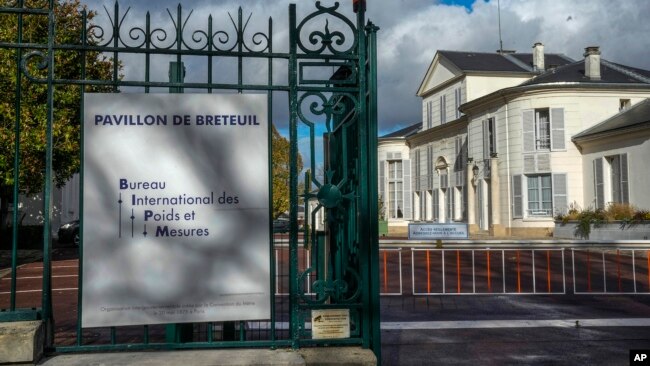"General Conference on Weights and Measures"国際度量衡総会、なるものがあったのですね。初めて知りました。
さて、どんな単位なんでしょうか?!
VOAで英語を学びましょう♬
最大・最小の測定値を表す用語が科学者により承認される(和訳)
Scientists Approve Terms for Largest, Smallest Measurements
Nov.28,2022
国際的な科学者グループが、最大と最小の大きさを表すメートル法の用語を拡大しました。
この変更は、フランスのパリ近郊で最近開催された第27回General Conference on Weights and Measures国際度量衡総会で決定されました。同会議は、科学的測定の国際基準を設定します。
新しい用語はprefixesプレフィックスと呼ばれるものです。prefixes(接頭辞・接頭語)とは、基本的な単語の前に置かれる単語、文字、数字のことで、その意味を変化させることができます。
※Suffix:サフィックス 接尾語・接尾辞 /後ろ(お尻)にくっつく文字列
メートル法で使われている既存の接頭語の例としては、キロやミリがあります。これらの接頭語をメートルという単位に加えると、キロメートルとミリメートルになります。
このように用語を組み合わせることで、大きさや距離を簡単に表現することができます。例えば、1,000メートルと言うより、キロメートルと言う方が簡単です。また、”1,000分の1メートル”よりも”ミリメートル”の方がはるかに簡単です。
メートル法の世界的な標準は、国際単位系と呼ばれるものです。この規格の変更は、世界中の科学者や政府の代表者によって決定されます。
新しい接頭語の推進を主導した英国の国立物理学研究所は、会議の決議で新しい変更が承認されたことを確認しました。
これは、国際単位系に新しい用語が追加されるのが30年以上ぶりであることを示すものです。会議に出席した代表者たちは、科学の進歩やデジタルデータの保存量の膨大な増加により、新しい接頭語の必要性が高まっていると述べています。
新しい接頭語は、”これまでに測定された最大と最小のレベル”を表現するために作られた、とリチャード・ブラウン氏は言います。彼は、国立物理学研究所の計測学部長です。
最大の単位を表す新しい用語はronnaロナとquettaケッタです。そして、最小単位を表す新しい表現は、rontoロントとquectoケクトです。
ronnaロンナは1の後に27個のゼロが続き、quettaケッタは30個のゼロで表されます。極端に小さいものを測る場合、rontoロントは小数点の後に27個のゼロが付き、quectoケクトは30個のゼロが付くことになります。
ブラウン氏はAP通信に対し、この新しい接頭語によって、科学者がすでに知っていることをより簡単に説明できるようになると語ります。彼は、地球の重さは約6ロナグラムと言います。一方、木星の重さは2ケタグラムと表現できます。
電子の質量は1ロンタグラムと表現できます。そして、科学者たちは今、スマートフォンの1バイトのデータが、その携帯電話の質量を1ケタグラム増やすと言うことができるのです。
ブラウン氏は、”観測可能な宇宙全体のdiameter 直径は、ちょうど1ロントメーターである”と述べています。
さらに、新しい名称は慎重に考えずに決めたわけではないと付け加えています。新しい接頭語の最初の文字は、他の接頭辞語や単位に使われていないものでなければなりません。
「’r’と’q’だけが、まだ使われていない文字なのです」と、ブラウンは言います。「それに続いて、ギリシャ文字に似た響きで、大きな数字の接頭辞は'a'で終わり、小さな数字は'o'で終わるという前例があります。」と。
ブラウン氏は、用語が追加されるのは”ハイ・タイム(良い時期)”であると指摘しています。「物事が拡大するにつれ、(我々は)新しい言葉が必要になってくるのです。たった数十年の間に、世界はまったく違う場所になったのです。」
Scientists Approve Terms for Largest, Smallest Measurements
An international group of scientists has expanded the metric terms used to express the largest and smallest measurements.
The changes were decided at a recent meeting of the 27th General Conference on Weights and Measures, which took place near Paris, France. The group sets international standards for scientific measurements.
The new terms are known as prefixes. A prefix is a word, letter or number placed before a base word to change its meaning.
Examples of existing prefixes used in the metric system are kilo- and milli-. When these prefixes are added to the metric unit meter, they become kilometer and millimeter.
This method of combining terms makes it easier to express size and distances. For example, saying “kilometer” is easier than having to say 1,000 meters. And using “millimeter” is much easier than having to say “one thousandth of a meter.”
The worldwide standard for the metric system is known as the International System of Units. Changes to this standard are decided by scientists and government representatives from around the world.
Britain’s National Physical Laboratory, which led the push for new prefixes, confirmed the new changes were approved in a resolution at the meeting.
It marked the first time in more than 30 years that new terms have been added to the International System of Units. Representatives attending the meeting said the need for new prefixes had grown because of scientific advances and huge increases in digital data storage.
The new prefixes were created to express “the biggest and smallest levels ever measured,” said Richard Brown. He is head of Metrology at the National Physical Laboratory.
The new terms for the largest units are ronna and quetta. And the new expressions for the smallest are ronto and quecto.
Ronna is represented by a one, followed by 27 zeros, while quetta has 30 zeros. For measuring extremely small things, ronto has 27 zeros after the decimal point, while quecto would have 30 zeros.
Brown told The Associated Press the new prefixes will make it easier for scientists to describe things they already known about. He said the Earth weighs about six ronnagrams. The weight of Jupiter, on the other hand, can be expressed as two quettagrams.
The mass of an electron can be described as one rontogram. And, scientists can now say that a single byte of data on a smartphone increases the phone’s mass by one quectogram.
Brown said “the diameter of the entire observable universe is just one ronnameter.”
He added that the new names were not chosen without careful thought. The first letter of the new prefixes had to be one that had not been used in other prefixes and units.
“There were only the letters ‘r’ and ‘q’ that weren’t already taken,” Brown said. “Following that, there’s a precedent that they sound similar to Greek letters and that big number prefixes end with an ‘a’ and smaller numbers with an ‘o.’"
Brown noted that it was “high time” for the terms to be added. “(We) need new words as things expand,” Brown said. “In just a few decades, the world has become a very different place.”
Words in This Story
unit – n. a measure used to express an amount or quantity
standard – n. a level of quality, especially one that is acceptable
advance – n. a new discovery or invention
diameter – n. a straight line that goes from one side of a circle to the other side and through the center, or the length of this line
precedent – v. an action or decision that is used as an example when someone wants to do a similar thing in the future
decade – n. a period of 10 years
